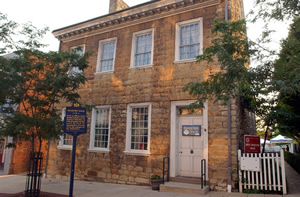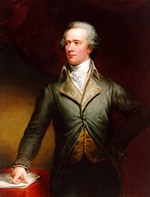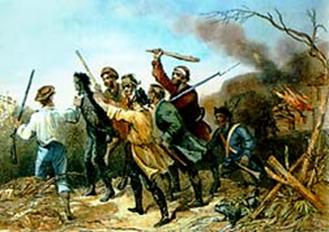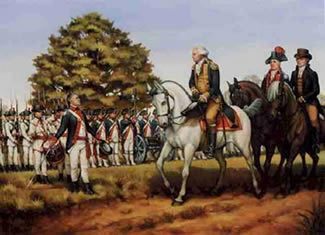
The Bradford House in Washington, Washington County is imbued with architectural and historical significance. Completed in 1788 and restored to its original eighteenth-century style in 1963, this was the first stone house built in Washington and was occupied by David Bradford, the Deputy Attorney General of Washington County, and his family from 1788 until 1794. During this period, Bradford was involved in the Whiskey Rebellion, when tensions over the refusal of citizens in Allegheny, Washington, Fayette, and Westmoreland counties to pay a federal excise tax on whiskey almost escalated to civil war.
This episode was significant in bringing to the fore many unresolved ideological issues and social tensions in early American society. It provided President George Washington and Secretary of the Treasury Alexander Hamilton with an opportunity to test principles of Federalism and was also an impetus for the formation of the Democratic Republicans, the first opposition party in American history.
Pennsylvania was a microcosm of the increasing political differences between those in the ‘settled’ eastern part of the United States and those on the ‘wild’ frontier during the late eighteenth-century. The frontiersmen, essentially those living west of the Appalachian Mountains, fiercely defended their autonomy and felt unrepresented by state and national governments. In his 1994 study of the Rebellion, historian Jerry Clouse asserted that “distrust of an unresponsive government pervaded the frontier political identity.” Additionally there was a festering resentment of social and political elites, who locals perceived to be flourishing as they struggled desperately to survive.

The 25% excise tax on distilled whiskey, drawn up primarily by Alexander Hamilton, was passed by Congress on March 3, 1791. While the tax was justified as a luxury tax, whiskey was more than just a luxury item on the frontier. The only profitable method for small farmers to transport grain over the mountainous regions of western Pennsylvania was in the form of whiskey. As money was scarce in this area, whiskey was often traded for other important resources in a bartering system. Many on the frontier also saw the tax as favoring larger whiskey producers based in the east to the detriment of the small western farmers who would not be able to afford it.
In Pennsylvania, as in other frontier regions, initial attempts to enforce the tax were met with stark and violent resistance. In the fall of 1791, Robert Johnson, a tax collector, was assaulted by a group of 16 men dressed as women. He was beaten, stripped, shaved, tarred and feathered, and then forced to denounce the United States Government and rip up his records. Johnson was lucky to live through the ordeal. For the next few years, anyone collecting the tax or assisting tax collectors was similarly punished with violence and humiliation by disgruntled mobs of local farmers. Holes were shot in the stills of those who merely complied with the tax.

While authorities in most other areas soon opted not to enforce the excise, officials in Pennsylvania redoubled their efforts in 1794. General John Neville (1731-1803), a Virginia-born patrician and Revolutionary war veteran, was hired by the Federal Government to supervise the collection of taxes in western Pennsylvania. As if Neville’s upper class background, outsider status, and insistence on strictly enforcing the excise weren’t bad enough, he was also a large-scale whiskey producer. Since the tax would drive small-scale distilleries out of business, he was, in the words of historian William Hogeland, “the leading local beneficiary of the tax.” Neville became an infamous figure, hated by locals for what was perceived to be his ruthless pursuit of economic self-interest.
Displeased with the increase of unrest in western Pennsylvania and hoping to ease the situation, President Washington approved a bill in June, 1794 making it possible for tax cases to be heard in local courts. He hoped that removing the economic hardship of traveling to federal courts in Philadelphia would be viewed as an adequate concession.
There is no telling if this measure would have worked because, inexplicably, on July 15, 1794 U.S. Marshall David Lenox, accompanied by Neville, served excise resistors with summons to Philadelphia courts rather than local ones. Word spread quickly and that afternoon a group of local farmers and militiamen marched to Neville’s mansion on Bower Hill in Allegheny County with the mistaken belief that Lenox was hiding there. Early the next morning, gunfire was exchanged and one militiaman was mortally wounded before the rebels beat a hasty retreat.
That night, the ranks of the rebellion grew to between 500 and 700 men and a small force of U.S. troops was called in to protect Neville’s house. According to Hogeland, this battle “wouldn’t be a raid by a gang but an expedition by a large, disciplined fighting force, mobilized without orders from any legal authority, offering to do battle with a division of the U.S. Army.” This was more than just a typical riot. Although estimates vary, approximately one or two U.S. soldiers died along with three or four local militiamen. Major James Kirkpatrick, the commander in charge of protecting Neville’s property was captured and Neville’s complex was burned to the ground. The country was teetering on the brink of civil war.
After a series of local meetings failed to establish the goals of the Rebellion, local militias mustered at Braddock’s Field, a mere eight miles from Pittsburgh, on August 1, 1794. Pittsburgh was viewed as the base of local elites who sympathized with the tax. Over the next few days, radical factions of the movement seemed intent on looting and burning Pittsburgh. In an effort to appease the rowdy rebels, the citizens of Pittsburgh expelled several well-known Federalist sympathizers, sent men to join the militia, and promised free whiskey in exchange for a peaceful march through the city. Satisfied by these measures and unwilling to provoke a national crisis, this 5,000 man march into Pittsburgh proceeded peacefully.

On September 25, 1794, President Washington proclaimed that the members of the Pennsylvania, New Jersey, Maryland, and Virginia militias would march westward to put down the insurrection. Washington led a force of around 15,000 men westward to the four offending counties. This marked the first time under the U.S. Constitution that a national military force was used to exert the U.S. Government’s authority over American citizens.
When the U.S. troops reached western Pennsylvania they only found “liberty poles” adorned with slogans from the French Revolution and met with no open resistance. Although 150 men were taken back to Philadelphia, only 23 were tried. Due to lack of evidence, only two men were found guilty and both were pardoned by President Washington.

David Bradford was the only participant in the rebellion not to be pardoned. Already a prominent member of the community, Bradford became one of the leaders of the anti-excise movement after giving several rousing anti-government speeches. It has been speculated that Bradford took such a fierce stance out of a fear of having his own property damaged by the mob. Bradford left Pennsylvania for Spanish-owned West Florida (modern-day Louisiana) before federal troops reached Washington County and only briefly returned to the United States once to retrieve some possessions in 1801. The excise on whiskey was repealed under President Jefferson in 1802.
Sources:
- Baldwin, Leland. Whiskey Rebels: The Story of a Frontier Uprising, Revised Edition. Pittsburgh: University of Pittsburgh Press, 1967.
- Clouse, Jerry A. The Whiskey Rebellion: Southwestern Pennsylvania’s People Test the American Constitution. Harrisburg, Pa.: The Pennsylvania Historical and Museum Commission, 1994.
- Cooke, Jacob E. “The Whiskey Insurrection: A Re-evaluation.” Pennsylvania History 13. 2 (1963): 316-346.
- “The Diaries of George Washington 30 September-19 October 1794.” The Papers of George Washington, Alderman Library, University of Virginia. Oct. 12 2007. http://gwpapers.virginia.edu/documents/whiskey/index.html
- Hogeland, William. The Whiskey Rebellion: George Washington, Alexander Hamilton, and the Frontier Rebels Who Challenged America’s Newfound Sovereignty. New York: Scribner, 2006.
- Slaughter, Thomas P. The Whiskey Rebellion: Frontier Epilogue to the American Revolution. New York: Oxford University Press, 1986.
- Washington, George. “A Proclamation on the Whiskey Rebellion.” Claypoole’s Daily Advertiser 7 Aug. 1794. The Avalon Project at Yale Law School. Yale University. Oct. 12, 2007. Oct. 12 2007. <http://avalon.law.yale.edu/18th_century/gwproc03.asp>.
- ————. “Sixth Annual Message to Congress, November 19, 1794.” The Avalon Project at Yale Law School. Yale University. Oct. 12 2007. Oct. 12 2007.<http://avalon.law.yale.edu/18th_century/washs06.asp>.
